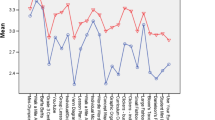Abstract
Constructivist instruction has been implemented in the current instructional innovation in Singapore. Large scale survey study was conducted to examine the roles of teacher efficacy in implementing the innovative constructivist instruction. The results showed that the positive correlation between teacher efficacy and constructivist instruction was stronger than the correlation between teacher efficacy and didactic instruction. The study suggests that policy makers and school leaders should try to improve teacher’s efficacy beliefs so that innovative instruction could be effectively implemented by school teachers.
Similar content being viewed by others
References
Allinder R. M. (1994) The relationship between efficacy and the instructional practices of special education teachers and consultants. Teacher Education and Special Education 17: 86–95
Bandura A. (1994) Self-efficacy. In: Ramachaudran V. S. (Ed.), Encyclopedia of human behavior. Academic Press, New York, pp 71–81
Bandura A. (1997) Self-efficacy: The exercise of control. Freeman, New York
Brown A. L., Palincsar A. S. (1989) Guided cooperative learning and individual knowledge acquisition. In: Resnick L. B. (Ed.), Cognition and instruction: Issues and agendas. Erlbaum, Hillsdale, NJ, pp 393–451
Cantrell S. C., Callaway P. (2008) High and low implementers of content literacy instruction: Portraits of teacher efficacy. Teaching and Teacher Education 24: 1739–1750
Chua S. K. C. (2009) Futuristic schools: “Little Red Dot” strategies in a globalised economy. International Journal of Learning 16: 393–404
Cohen J. (1988) Statistical power analysis for the behavioral sciences. Lawrence Earlbaum Associates, Hillsdale, NJ
Friedman I. A., Kass E. (2002) Teacher self-efficacy: A classroom-organisation conceptualisation. Teaching and Teacher Education 18: 675–686
Fullan M. (2001) The new meaning of educational change. Teachers College Press, New York
Ghaith G., Yaghi H. (1997) Relationship among experience, teacher efficacy, and attitudes towards the implementation of instructional innovation. Teaching and Teacher Education 13: 451–458
Guskey T. R. (1988) Teacher efficacy, self-concept, and attitudes toward the the implementation of instructional innovation. Teaching and Teacher Education 4: 63–69
Guthrie J. T., Van Meter P., Hancock G. R., Alao S., Anderson E., McCann A. (1998) Does concept-oriented reading instruction increase strategy use and conceptual learning from text?. Journal of Educational Psychology 90: 261–278
Guthrie J. T., Van Meter P., McCann A. D., Wigfield A., Bennett L., Poundstone C. C., Rice M. E., Faibisch F. M., Hunt B., Mitchell A. M. (1996) Growth of literacy engagement: Changes in motivations and strategies during concept-oriented reading instruction. Reading Research Quarterly 31: 306–332
Guthrie J. T., Wigfield A., Barbosa P., Perencevich K. C., Taboada A., Davis M. H., Scafiddi N. T., Tonks S. (2004) Increasing reading comprehension and engagement through concept-oriented reading instruction. Journal of Educational Psychology 96: 403–423
Guthrie J. T., Wigfield A., VonSecker C. (2000) Effects of integrated instruction on motivation and strategy use in reading. Journal of Educational Psychology 92: 331–341
Hacker D. J., Tenent A. (2002) Implementing reciprocal teaching in the classroom: Overcoming obstacles and making modifications. Journal of Educational Psychology 94: 699–718
Hamilton D. T., Moore A. L., Pellegrino J. W. (2001) The motivational and academic consequences of elementary mathematics environments: Do constructivist innovations and reforms make a difference?. American Educational Research Journal 38: 611–652
Hickey L. S., McCaffrey D. F., Stecher B. M., Klein S. P., Robyn A., Bugliari D. (2003) Studying large-scale reforms of instructional practices: An example from mathematics and science. Educational Evaluation and Policy Analysis 25: 1–29
Luke A., Rahim R. A., Koh K. H., Lau S., Ismail M., Hogan D. (2005) Innovation and enterprise in classroom practice: A discussion of enabling and disenabling pedagogical factors in P5 and S3 classrooms. Centre for Research in Instruction and Practice, Singapore
Ministry of Education, Singapore. (2009). Report of the Primary Education Review and implementation committee. Retrieved from http://planipolis.iiep.unesco.org/upload/Singapore/Singapore_SERI_2010.pdf.
Mullis I. V. S. (2000) TIMSS 1999 Mathematics items: Released set for eighth grade. International Study Centre, Boston
Newmann F. M. et al (1996a) Authentic achievement—restructuring schools for intellectual quality. Jossey-Bass Publishers, San Francisco
Newmann F. M., Marks H. M., Gamoran A. (1996b) Authentic instruction and student performance. American Journal of Education 104: 280–312
Nie Y., Lau S. (2010) Differential relations of traditional and constructivist instruction to students’ cognition, motivation, and achievement. Learning and Instruction 20: 411–423
Palincsar A. S., Brown A. L. (1984) Reciprocal teaching of comprehension-fostering and comprehension-monitoring activities. Cognition and Instruction 2: 117–175
Partnership for 21st Century Skills. (2009). Curriculum and instruction: A 21st century skills implementation guide. http://p21.org/documents/p21-stateimp_curriculuminstruction.pdf.
Perkins D. (1999) The many faces of constructivism. Educational leadership 57(3): 6–11
Saklofske D. H., Michayluk J. O., Randhawa B. S. (1988) Teachers’ efficacy and teaching behaviors. Psychological Reports 63: 407–414
Sharpe L., Gopinathan S. (2002) After effectiveness: New directions in the Singapore school system?. Journal Educational Policy 17: 151–166
Shuell T. J. (1996) Teaching and learning in a classroom context. In: Berliner D. C., Calfree R. C. (Eds.), Handbook of educational psychology. Simon & Schuster Macmillan, New York, pp 726–764
Smerdon B. A., Burkam D. T., Lee V. E. (1999) Access to constructivist and didactic teaching: Who gets it? Where is it practiced?. Teacher College Record 101: 5–34
Smith J. B., Lee V. E., Newmann F. M. (2001) Instruction and achievement in Chicago elementary schools. Consortium on Chicago School Research, Chicago, IL
Tan C. (2006) Creating thinking schools through ‘Knowledge and Inquiry’: The curriculum challenges for Singapore. Curriculum Journal 17: 89–105
Tschannen-Moran M., Woolfolk Hoy A. (2001) Teacher efficacy: Capturing an elusive construct. Teaching and Teacher Education 17: 783–805
Woolfork A. E., Hoy W. K. (1990) Perspective teachers’ sense of efficacy and believe about control. Journal of Educational Psychology 82: 81–91
Author information
Authors and Affiliations
Corresponding author
Additional information
Youyan Nie and Gim Hoon Tan contributed equally to this paper.
Rights and permissions
About this article
Cite this article
Nie, Y., Tan, G.H., Liau, A.K. et al. The roles of teacher efficacy in instructional innovation: its predictive relations to constructivist and didactic instruction. Educ Res Policy Prac 12, 67–77 (2013). https://doi.org/10.1007/s10671-012-9128-y
Received:
Accepted:
Published:
Issue Date:
DOI: https://doi.org/10.1007/s10671-012-9128-y




